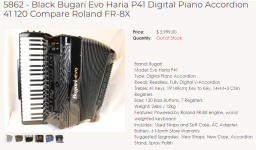Good man
@John M, you love your FR8X and I respect that. However, is the FR8X too heavy? Well, I suppose it depends on your perspective. I will give an opinion, but I don't want to be harsh in any way or seem unfair - really, there are a lot of things to like about the Roland accordions. I know a few members here who love the Roland accordions dearly, and I appreciate their decisions to buy what they like, and like what they buy, without hearing me criticise their choices. I trust their judgement and I am sure they will be good products. I too would have a digital accordion, but I look for different things than what Roland is content to give us... For me, there is an optimum weight and dimensions for a piano accordion. I personally like 41/120 (or at a minimum 37/120) with 4 voice and double cassotto. However, I do not like instruments that have great dimensional 'depth'. I am baffled by the depth figure that Roland quotes on their website, 28cm? What did they use to measure the accordion - a trundle wheel. Maybe someone can share the correct dimensions for my benefit. To me the golden number is around 19cm to 19.5cm depth for a sleek, well designed traditional accordion. Five voice instruments and chromatic converter accordions all tend to be at least 2.5cm deeper. I believe this affects the centre of gravity of the instrument and the accordion sits up on itself rather than laying into the musician. Secondly, weight. To me a traditional standard bass 41/120 should really be less than 12kg (not a fan of the square and chunky Excelsior Symphony Gold). I would even say that many of the great Titano and Victorias with quint converters in the olden days were often pretty close to the 19.5cm/20cm depth and often hovering under the 12kg mark. That's simply great design to me. However, accordions are getting bigger as bass mechanisms and instruments with larger note ranges need to be accomodated. Not my thing at all! But why is a digital accordion as heavy as one made from wood, metal, celluloid and all the other goodies?
I feel that right now the digital accordion companies take their digital accordionists for granted. Technology changes quickly these days, but not when it's inside an accordion. Now, according to Roland the FR8X weighs 12.1kg for their 41 key and 120 bass accordion. Now, that's not terrible but it is heavier than a vintage Hohner Gola 414. The Gola 414 weighs-in at a bit over 11kg. However, what's inside a Gola? Well the casing is made from a ply of aged mahogany and spruce. The reed blocks are made from a combination of spruce and highly varnished black walnut. The hundreds of steel reeds inside the accordion are of a quality that has never been matched in the history of accordion building. Bellows frames are solid walnut. The keyboard base is made from walnut and it has an aluminium mute-box behind the grill. Parts of the grill and the bass couplers are gold-plated. The whole instrument is covered in highly polished celluloid, a material that's rarely used nowadays on anything other than accordions and a few other bits and pieces, but celluloid really has a wonderful lustre to it! That's even before we talk about the mechanics. Also, the dimensions are as important as the weight, especially the depth that is 19.5cm. When you hold a Gola 414 or a Super VI or a classic Excelsior, Sonola, Titano, Victoria, or modern Beltuna, Bugari or Pigini you are playing an instrument of great substance and sleek design.
Yet the Roland FR8X, why is the technologically advanced option so heavy? Surely modern tech is getting smaller, lighter and more capable? But no, not on accordions. Where is the weight coming from? The case and keys are plastic, not made of hard-wood and topped with celluloid and lucite like good modern accordions. No doubt the FR8X is loaded with computer components, microchips, sensors, wiring and speakers. Maybe, this is all top notch, cutting edge 2023 stuff? Old tech usually gets cheaper with time, but seemingly not on a digital accordion.
I shudder at where the multinational corporations are going... Roland feeds us what they decide and we have to either accept it and believe it is the best thing since pressed beetroot juice, or wait for them to slowly evolve their product. I don't mind the sounds, some are really nice. I like the piano, and some of the organ and orchestal sounds, they can be quite pleasant. As for the Scrooge McDuck bagpipes that the occasional American Youtuber likes to use to make Scottish people cringe - the less said about that the better.
I remain ever hopeful that one day there will be a digital instrument with uncluttered design, high quality plastics, maybe with a quality keyboard. But regardless, they should really be lighter than 12kg. Is that too much to ask? Maybe one day Roland will surprise me.



